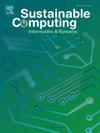Optimizing IoT network lifetime through an enhanced hybrid energy harvesting system
IF 3.8
3区 计算机科学
Q1 COMPUTER SCIENCE, HARDWARE & ARCHITECTURE
引用次数: 0
Abstract
The growing need for sustainable and renewable energy sources has become critical with the Internet of Things (IoT) advancement. IoT relies on low-power, battery-operated devices, but the limited lifespan of these batteries requires frequent recharging or replacement, which is costly and time-consuming. Researchers have proposed energy harvesting systems that capture sustainable ambient energy from the environment to address this issue. This paper presents a hybrid system for harvesting sustainable energy from solar and wind sources. The system features a boost converter controlled by a novel hybrid method combining the Honey Badger Algorithm (HBA) and Harris Hawks Optimization (HHO). This method maximizes power extraction from solar and wind sources, enhancing overall system efficiency. Additionally, the system includes an innovative energy management algorithm that selects the most powerful input source while protecting the storage battery from overcharging or complete depletion, thereby extending its lifespan. The proposed design is validated through MATLAB/Simulink simulations. The HHO–HBA MPPT is compared with existing MPPT methods, evaluating efficiency, battery charge curves, and IoT network energy status. Simulation results show that the proposed approach significantly increases network longevity, offering a cost-effective and sustainable solution for the energy needs of Wireless Sensor Network (WSN)-IoT devices.
通过增强的混合能量收集系统优化物联网网络寿命
随着物联网(IoT)的发展,对可持续和可再生能源日益增长的需求变得至关重要。物联网依赖于低功耗、电池供电的设备,但这些电池的寿命有限,需要经常充电或更换,这既昂贵又耗时。研究人员提出了能量收集系统,从环境中捕获可持续的环境能量来解决这个问题。本文介绍了一种从太阳能和风能中获取可持续能源的混合系统。该系统采用一种结合蜂蜜獾算法(HBA)和哈里斯鹰优化(HHO)的新型混合方法控制升压变换器。这种方法最大限度地利用太阳能和风能,提高了整个系统的效率。此外,该系统还包括一种创新的能量管理算法,可以选择最强大的输入源,同时保护蓄电池不会过度充电或完全耗尽,从而延长其使用寿命。通过MATLAB/Simulink仿真验证了所提出的设计。将HHO-HBA MPPT与现有的MPPT方法进行比较,评估效率、电池充电曲线和物联网网络能量状态。仿真结果表明,该方法显著提高了网络寿命,为无线传感器网络(WSN)-物联网设备的能源需求提供了经济有效且可持续的解决方案。
本文章由计算机程序翻译,如有差异,请以英文原文为准。
求助全文
约1分钟内获得全文
求助全文
来源期刊

Sustainable Computing-Informatics & Systems
COMPUTER SCIENCE, HARDWARE & ARCHITECTUREC-COMPUTER SCIENCE, INFORMATION SYSTEMS
CiteScore
10.70
自引率
4.40%
发文量
142
期刊介绍:
Sustainable computing is a rapidly expanding research area spanning the fields of computer science and engineering, electrical engineering as well as other engineering disciplines. The aim of Sustainable Computing: Informatics and Systems (SUSCOM) is to publish the myriad research findings related to energy-aware and thermal-aware management of computing resource. Equally important is a spectrum of related research issues such as applications of computing that can have ecological and societal impacts. SUSCOM publishes original and timely research papers and survey articles in current areas of power, energy, temperature, and environment related research areas of current importance to readers. SUSCOM has an editorial board comprising prominent researchers from around the world and selects competitively evaluated peer-reviewed papers.
 求助内容:
求助内容: 应助结果提醒方式:
应助结果提醒方式:


